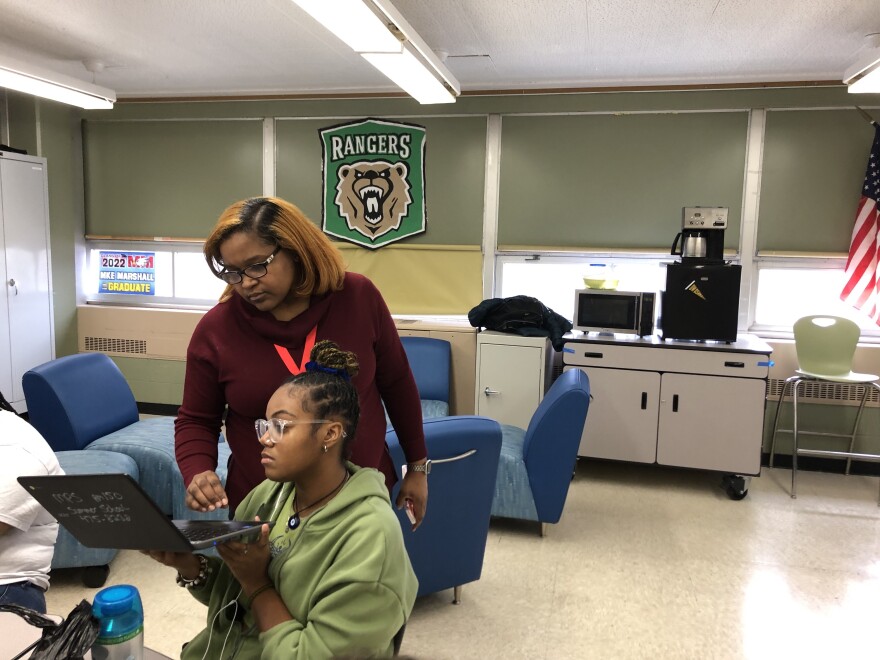Last November, college and career advisor Parice Beckley was working to get each of Milwaukee's Marshall High School’s 190 seniors to fill out the FAFSA.
"Students automatically think, oh if I apply for the FAFSA, I have to take out a loan," Beckley said. "No. What the financial aid application is doing is telling you how much you’re eligible to receive in financial assistance from the government."
Financial assistance in the form of Pell grants, which you don’t have to pay back, or loans, which you do.
The number of Marshall High School students headed to college plummeted during the pandemic. Previously, more than a third of grads enrolled in college. In 2021, the number had dropped to about one in 10.
MPS serves predominately low-income students of color, and across the district, fewer graduates were pursuing higher education.
"Many of our families foreclose on the idea of college, and our students do as well, based on the perception that the financial aspect will be a major obstacle," says MPS College Access Coordinator Ericca Pollack. "We want to assure that they have access to all opportunities."
To get more students on a path to college, last school year, MPS started requiring graduating seniors to fill out or opt out of the FAFSA.
The FAFSA is the Free Application for Federal Student Aid, which unlocks federal grants and loans, based on family income, to pay for college.

Bill DeBaun is senior director with the National College Attainment Network, or NCAN. He says filling out the FAFSA doesn’t mean a student will go to college, but it’s a good indicator.
"FAFSA completion is strongly associated with immediate postsecondary enrollment," DeBaun says. "And that’s especially true for students coming from higher poverty school districts. So where we see FAFSA completion increasing, we generally tend to see similar increases in the fall postsecondary enrollment rate following that high school graduation."
Louisiana, Alabama, Texas, California and Illinois have implemented statewide FAFSA graduation requirements, and have seen positive results. Wisconsin has no such requirement. But MPS decided to implement its own last school year.
"The first year of the FAFSA graduation requirement, the implementation was definitely successful," Pollack says. "Our goal was to increase both knowledge and completion of the FAFSA, and we certainly saw that in our completion."
Pollack says as of June 2, MPS’s FAFSA completion rate increased from 41% in 2022 to 58% in 2023.
Some schools, like Milwaukee Marshall and South Division, saw their FAFSA completion rates skyrocket — reaching dozens more students than the previous year.
MPS said no students were prevented from graduating if they didn't fill out the FAFSA. They were allowed to opt out of the FAFSA requirement.
"Really what was required was a conversation about the FAFSA," Pollack says. "So what we can say is that happened with 100% of students."
Bill DeBaun, with the NCAN, says Milwaukee’s 17 percentage-point increase in FAFSA completion is impressive.
"Getting that kind of increase, to me, suggests pretty strong buy-in from students to participate in the policy," he says.
Of course, DeBaun says, the FAFSA isn’t the end-all be-all of increasing college access. Students also need support filling out college applications, choosing a school that's a good fit, and they need help once they’re on campus to stay enrolled and actually earn a degree.
"These policies, their ultimate goal isn’t for more students to complete the FAFSA," DeBaun says. "It’s for more students to enroll and attain a postsecondary education."
We don’t know yet whether MPS’s higher FAFSA completion will lead to higher college enrollment. The district says those numbers won't be available until the fall. But MPS administrators are hopeful, and they say they’ll double-down on FAFSA efforts in the upcoming school year.
There is a new obstacle, however. The federal government is simplifying the FAFSA, which should help in the long-run, but it will delay when the application opens, to December.
That means students will have to wait until the second half of the school year to apply for federal college financial aid.
_






